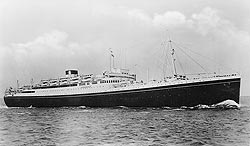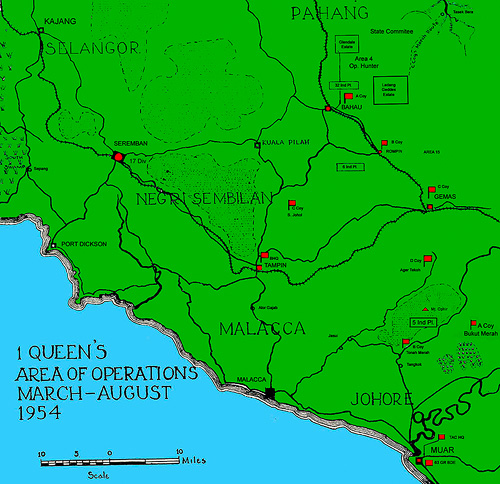Malaya 1954 Malacca & Mount Ophir
| HMT "Georgic". (Click to view enlarged) |
|
1st Battalion The Queen's Royal Regiment commanded by Lieutenant Colonel F J C Piggott, DSO, OBE, disembarked from the troopship Georgic at Singapore on the 12th February 1954, and staged in Selarang Barracks. After intensive jungle warfare training in South Johore, the Battalion moved to the Malacca area, taking over from 1st Gordons. Widely scattered, with Battalion HQ, Support and HQ Companies at Tampin, 'A' and 'B' Companies at Rompin about 30 miles NE , 'C' Company at South Johol between Tampin and Rompin, and 'D' Company at Ayer Tekah about 50 miles away in the foothills of the 4187 ft Mount Ophir. a centre of terrorist activity. Soon 'A' Company moved on to Bahau another terrorist trouble-spot 10 miles NW of Rompin. The 'Dog Platoon', a new unit, with 14 Patrol and Tracker dogs plus handlers, joined Support Company.
A CT surrendered to 'B' Company the first day the Battalion became operational, but otherwise except for 'D' Company, Companies were engaged in routine duties guarding Chinese settlements and checking food supplies in support of an ongoing major operation.
On the 12th April, the Battalion's first successful operation was an ambush by a patrol of 'B' Company under 2/Lieutenants M J Doyle and M C Greenleaf - In the late afternoon guided by an informant, the 16 strong patrol, moved off in M.T. from Company HQ, and debussed at 1730hrs with one and a half hours of daylight remaining. The very nervous informant led them to a small clearing, which he said was used by CTs on most nights. While the patrol was still getting into position, lights were seen approaching and three figures came within touching distance. When the leading one was about three yards away the Patrol Commander shouted 'Fire' ; the noise was deafening. When fire was stopped, a search party found one body and two packs, and after an uneasy night's rest, a further search disclosed another body and a third blood-stained pack, but the blood trail petered out.
Meanwhile 'D' Company was engaged in numerous ambushes and patrols both on Mount Ophir and among tidal swamps. Two CTs surrendered to 11 Platoon, and four days later 2/Lieutenant J G W Davidson's 10 Platoon guided by a surrendered terrorist, ambushed two CTs in the marshes. Cpl Chinn killed one with a standing snapshot; the other escaped wounded.
At the end of April, a tactical Battalion HQ with 'D' Company and 'C' from South Johol, mounted a combined operation in the Mount Ophir area; the target, a supposed Communist State Committee Meeting. Five ambush parties were positioned to intercept the CTs, which it was hoped 2/Lieutenant G C Sharpe's 9 Platoon would flush out, but despite the latter's exhausting sweep through the heights, nothing was found. Tragically, during this operation Sgt Jones, Ptes Fisher and Braybrook, and a local tracker lost their lives.
'C' Company under Major R S N Mans, now moved - one platoon by air and the remainder including the Mortar Platoon, by difficult march, to Fort Iskander, an isolated police post in deep jungle 22 miles NW of Bahau, to protect and gain the confidence of the very friendly Semalan aborigines. Supply was entirely by air-drop, which worked well. 9 Platoon remained at the Fort as supply link and carrying out local medical patrols, while the other platoons patrolled the swamp and jungle round the Tasek Bera Lake both on foot and by boat.
1 Queen's area of operations, March - August 1954.
(Click to enlarge)
On the 7th May, while 'D' Company was patrolling and mounting ambushes round Mount Ophir, 10 Platoon killed two CTs, one a Branch Committee member. Later, on the 6th June, five CTs were contacted by 2/Lieutenant Greenleaf's 5 Platoon of 'B' Company, and engaged by Corporal Sibley and the Platoon's two Iban guides; Corporal Sibley was wounded by a grenade and his water-bottle now in the Regimental Museum, shattered. The patrol then charged, killed two CTs and wounded a third, who got away.
'C' Company under Major J U Stobbs, operated for a month in deep jungle supplied by air, finding and destroying CT food cultivations, while 'A' and 'B' companies took part in a combined operation between 13th/17th June, when a CT camp was found, but unoccupied. On the 20th, 4 Platoon ambushed four CTs, killing one at short range, and two more as they dodged through rubber trees. On the 23rd, 10 Platoon were searching the southern slopes of Mount Ophir, and as they crossed a torrent, a CT bobbed up and was instantly shot by 2/Lieutenant M J Foster, attached to the Platoon for experience and on his first patrol. The CT found to be a State Committee Member carrying valuable documents, was the most important kill in the area for years On the 30th, a patrol of 'C' Company's 9 Platoon under Cpl Furlonger, killed two 'CTs' near South Johol. On the 1st July the Battalion came under command 63 Gurkha Infantry Brigade with the aim of attacking in conjunction with 2/6 Gurkha Rifles, the CT 'Border Committee' which operated mainly in the Mount Ophir area. Between the 3rd and 8th July 'B' & 'D' Companies operating in the jungle, came across a group of CTs bathing, who bolted naked, leaving their clothes and stationery.
However 'A' Company commanded by Major I P Thompson MC, was detached to 1st Somerset Light Infantry at Kajang, 100 miles North, but so thoroughly had the area already been patrolled, that no CTs could be found. On 24th July, 3 Platoon moved SW to deal with a CT camp which had been detected in the swamps West of Sepang. The RAF attacked first, and the Platoon was then lifted in by helicopter, sliding down ropes into the swamp. The camp was found empty, but the Platoon lived there for four days during which a patrol under Cpl Banks shot one CT. Tragically though, 2/Lieutenant R M Townsend was killed during the operation. At the month's end, 'A' Company rejoined the Battalion at Bukit Serempan near Mount Ophir, with 'B' at Tanah Merah and 'D' at Ayer Tekah, all involved in constantly patrolling the precipitous slopes and surrounding swamps. 'C' Company remained at South Johol, also patrolling. Similar action continued throughout August, and on the 19th 2/Lieutenant Doyle's 4 Platoon killed two 'CTs'.
This persistent patrolling had collected much information, and on the 27th August the mountain was subjected to a week's continuous harassing mortar and artillery fire as well as bombing from the air. Millions of leaflets were dropped urging the CTs to surrender, and to facilitate their doing so, all military movement was banned between the 4th and 6th September when the operation ended. Only three surrenders took place, but later 2/Lieutenant B D Bartlett's 1 Platoon of 'A' Company ambushed and killed two CTs.
In August apart from military operations, the Battalion had outstanding success at the Malaya Rifle Meeting. Teams were first in the Major Units Rifle Match, Open Invitation Rifle Match, and Major Units Falling Plate. Corporal Nickson was 1st and Lieutenant P G Collyer 3rd in the Individual Rifle Match - the Battalion could strongly claim to be the best shooting unit in Malaya Command.
'B' Company now moved East to Labis, and 'C' North to Gemas where they lay-up in local 'gardens' suspected as a source of food supply for CTs.
On the 27th September and throughout October, Operation 'Trapper' was ongoing on Mount Ophir, where it was believed an important CT Committee Meeting was to be held. A jungle base 'Braganza Camp' was maintained on the mountain by 'D' Company' under Major M A Lowry, and Platoons of other Companies attached from time to time. Despite patrolling and protracted ambushes, no CTs were killed, but the mountain had been made so uncomfortable for them that the Committee Meeting and indeed, the whole mountain was abandoned, and the CTs moved to the more unsavoury swamp-lands below. After 'Trapper'. one platoon frequently rotated, was always maintained on the mountain.
On the 18th November, Lieutenant Colonel Piggott relinquished command on promotion, and Lieutenant Colonel H R D Hill MBE, succeeded him.
An important operational factor In Malaya, was the continuing change-over of officers, NCOs and men, which made the high all- round standard maintained, all the more creditable. This was largely due to the care taken in training drafts from the United Kingdom. They did not join their Companies for six weeks, two of which were spent in acclimatization, two learning to live and shoot in the jungle, and two on long patrols under instructors in quiet areas.
An important operational factor In Malaya, was the continuing change-over of officers, NCOs and men, which made the high all- round standard maintained, all the more creditable. This was largely due to the care taken in training drafts from the United Kingdom. They did not join their Companies for six weeks, two of which were spent in acclimatization, two learning to live and shoot in the jungle, and two on long patrols under instructors in quiet areas.
An important operational factor In Malaya, was the continuing change-over of officers, NCOs and men, which made the high all- round standard maintained, all the more creditable. This was largely due to the care taken in training drafts from the United Kingdom. They did not join their Companies for six weeks, two of which were spent in acclimatization, two learning to live and shoot in the jungle, and two on long patrols under instructors in quiet areas.


